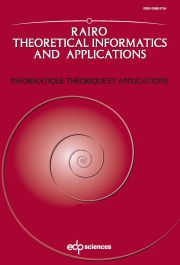Crossref Citations
This article has been cited by the following publications. This list is generated based on data provided by Crossref.
Guesnet, Yannick
2001.
Maximal circular codesversusmaximal codes.
RAIRO - Theoretical Informatics and Applications,
Vol. 35,
Issue. 4,
p.
351.
Guesnet, Yannick
2002.
On maximal codes with a finite interpreting delay.
Theoretical Computer Science,
Vol. 273,
Issue. 1-2,
p.
167.
Frey, Gabriel
and
Michel, Christian J.
2006.
Identification of circular codes in bacterial genomes and their use in a factorization method for retrieving the reading frames of genes.
Computational Biology and Chemistry,
Vol. 30,
Issue. 2,
p.
87.


